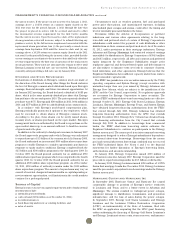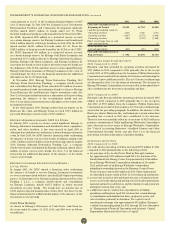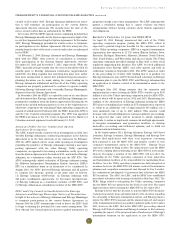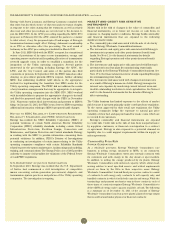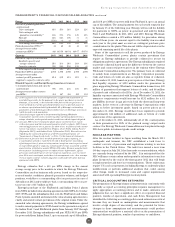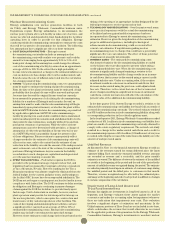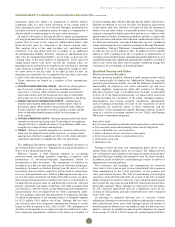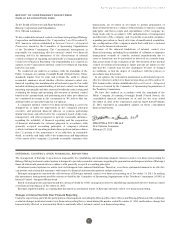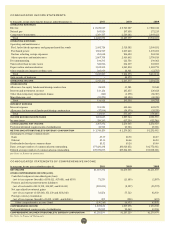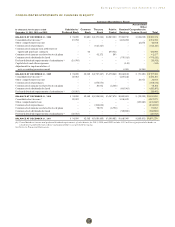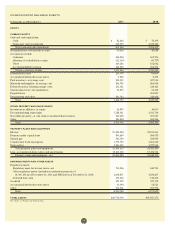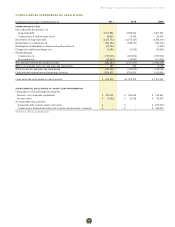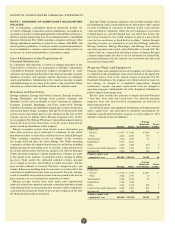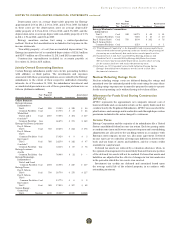Entergy 2011 Annual Report Download - page 55
Download and view the complete annual report
Please find page 55 of the 2011 Entergy annual report below. You can navigate through the pages in the report by either clicking on the pages listed below, or by using the keyword search tool below to find specific information within the annual report.
Entergy Corporation and Subsidiaries 2011
MANAGEMENT’S FINANCIAL DISCUSSION AND ANALYSIS concluded
contributed $76.1 million to its postretirement plans in 2011. Entergy’s
current estimate of contributions to its other postretirement
plans is approximately $80.4 million in 2012.
FE DE R AL HE A LTHCA R E LEG I SL ATI ON
The Patient Protection and Affordable Care Act (PPACA) became
federal law on March 23, 2010, and, on March 30, 2010, the Health
Care and Education Reconciliation Act of 2010 became federal law
and amended certain provisions of the PPACA. These new federal
laws change the law governing employer-sponsored group health
plans, like Entergy’s plans, and include, among other things, the
following significant provisions:
n A 40% excise tax on per capita medical benefit costs that exceed
certain thresholds;
n Change in coverage limits for dependents; and
n Elimination of lifetime caps.
The total impact of PPACA is not yet determinable because
technical guidance regarding application must still be issued.
Additionally, ongoing litigation and discussions are in progress
regarding the constitutionality of and the potential repeal of health
care reform, although whether that occurs and what parts of health
care reform would be invalidated or repealed is not yet known.
Entergy will continue to monitor these developments to determine
the possible impact on Entergy as a result of PPACA. Entergy is
participating in the programs currently provided for under PPACA,
such as the early retiree reinsurance program, which has provided
for some limited reimbursements of certain claims for early retirees
aged 55 to 64 who are not yet eligible for Medicare.
One provision of the new law that is effective in 2013 eliminates
the federal income tax deduction for prescription drug expenses of
Medicare beneficiaries for which the plan sponsor also receives the
retiree drug subsidy under Part D. Entergy receives subsidy payments
under the Medicare Part D plan and therefore in the first quarter 2010
recorded a reduction to the deferred tax asset related to the unfunded
other postretirement benefit obligation. The offset was recorded in
2010 as a $16 million charge to income tax expense or, for the Utility,
including each Registrant Subsidiary, as a regulatory asset.
Other Contingencies
As a company with multi-state domestic utility operations and
a history of international investments, Entergy is subject to a
number of federal, state, and international laws and regulations
and other factors and conditions in the areas in which it operates,
which potentially subject it to environmental, litigation, and other
risks. Entergy periodically evaluates its exposure for such risks
and records a reserve for those matters which are considered
probable and estimable in accordance with generally accepted
accounting principles.
ENVI R ONMENTAL
Entergy must comply with environmental laws and regulations
applicable to the handling and disposal of hazardous waste. Under
these various laws and regulations, Entergy could incur substantial
costs to restore properties consistent with the various standards.
Entergy conducts studies to determine the extent of any required
remediation and has recorded reserves based upon its evaluation of
the likelihood of loss and expected dollar amount for each issue.
Additional sites could be identified which require environmental
remediation for which Entergy could be liable. The amounts of
environmental reserves recorded can be significantly affected by the
following external events or conditions:
n Changes to existing state or federal regulation by governmental
authorities having jurisdiction over air quality, water quality,
control of toxic substances and hazardous and solid wastes, and
other environmental matters.
n The identification of additional sites or the filing of other
complaints in which Entergy may be asserted to be a potentially
responsible party.
n The resolution or progression of existing matters through the
court system or resolution by the EPA.
LITIGAT ION
Entergy is regularly named as a defendant in a number of lawsuits
involving employment, customers, and injuries and damages issues,
among other matters. Entergy periodically reviews the cases in
which it has been named as defendant and assesses the likelihood
of loss in each case as probable, reasonably estimable, or remote
and records reserves for cases which have a probable likelihood of
loss and can be estimated. Given the environment in which Entergy
operates, and the unpredictable nature of many of the cases in
which Entergy is named as a defendant, the ultimate outcome of the
litigation to which Entergy is exposed has the potential to materially
affect the results of operations of Entergy or Registrant Subsidiaries.
UNCERTAI N TA X POSITIO N S
Entergy’s operations, including acquisitions and divestitures,
require Entergy to evaluate risks such as the potential tax effects
of a transaction, or warranties made in connection with such a
transaction. Entergy believes that it has adequately assessed and
provided for these types of risks, where applicable. Any provisions
recorded for these types of issues, however, could be significantly
affected by events such as claims made by third parties under
warranties, additional transactions contemplated by Entergy, or
completion of reviews of the tax treatment of certain transactions or
issues by taxing authorities.
NEW ACCOUNTING PRONOUNCEMENTS
The accounting standard-setting process, including projects between
the FASB and the International Accounting Standards Board (IASB) to
converge U.S. GAAP and International Financial Reporting Standards,
is ongoing and the FASB and the IASB are each currently working on
several projects that have not yet resulted in final pronouncements. Final
pronouncements that result from these projects could have a material
effect on Entergy’s future net income or financial position, or cash flows.
In May 2011 the FASB issued ASU No. 2011-4, “Fair Value
Measurement (Topic 820): Amendments to Achieve Common Fair
Value Measurement and Disclosure Requirements in U.S. GAAP
and IFRSs,” which states that the ASU explains how to measure fair
value. The ASU states that: 1) the amendments in the ASU result
in common fair value measurement and disclosure requirements
in U.S. GAAP and International Financial Reporting Standards; 2)
consequently, the amendments change the wording used to describe
many of the requirements in U.S. GAAP for measuring fair value and
for disclosing information about fair value measurements; 3) for
many of the requirements, the FASB does not intend for the ASU to
result in a change in the application of the requirements of current
U.S. GAAP; 4) some of the amendments clarify the FASB’s intent about
the application of existing fair value measurement requirements; and
5) other amendments change a particular principle or requirement
for measuring fair value or for disclosing information about fair
value measurements. ASU No. 2011-4 is effective for Entergy for the
first quarter 2012. Entergy does not expect ASU No. 2011-4 to affect
materially its results of operations, financial position, or cash flows.
In September 2011 the FASB issued ASU No. 2011-8, “Intangibles
– Goodwill and Other (Topic 350): Testing Goodwill for Impairment.”
The amendments permit an entity to first assess qualitative factors
to determine whether it is more likely than not that the fair value
of a reporting unit is less than its carrying amount as a basis for
determining whether it is necessary to perform a quantitative goodwill
impairment assessment. ASU No. 2011-8 is effective for Entergy for
the first quarter 2012. ASU No. 2011-8 will have no effect on Entergy’s
results of operations, financial position, or cash flows.
53


